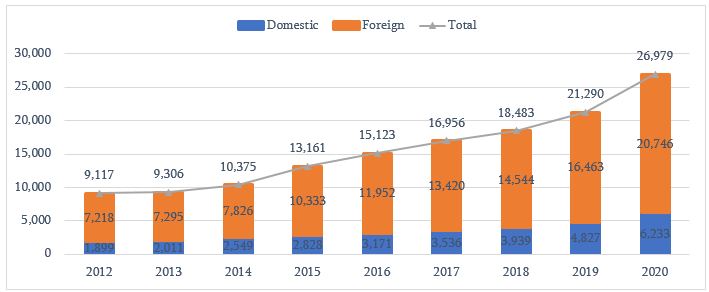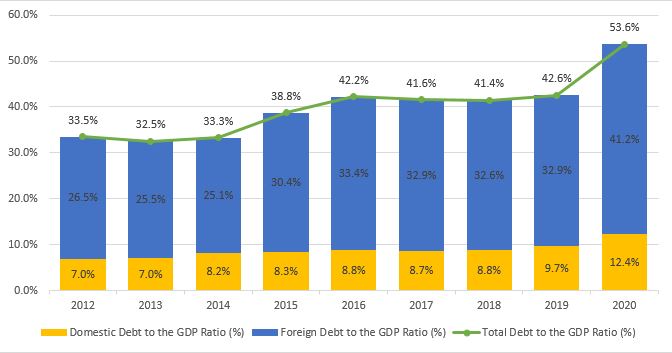Mikheil Saakashvili: “The total [domestic] debt to gross national [domestic] product ratio is over 60%.”
Verdict: FactCheck concludes that Mikheil Saakashvili’s statement is MOSTLY FALSE.
Resume: Mikheil Saakashvili literally mentioned the domestic debt, although it is clear from his full quote that he refers to the total national debt. The total national or government debt is the sum of the foreign and domestic national/government debts. As of 2020, the total national debt constitutes nearly GEL 27 billion, including GEL 6.2 billion in domestic debt and GEL 20.7 billion in foreign debt.
In regard to the accuracy of Mikheil Saakashvili’s figures, the statement still would not have been accurate if the third president of Georgia had referred to the total national debt instead of the domestic debt. . As of August 2020, the total national debt to the estimated GDP ratio is 53.6%, the domestic debt to the estimated GDP ratio is 12.4% and the foreign debt to the estimated GDP ratio is 41.2%. According to the current data, neither the total national debt nor the domestic debt to GDP ratio has gone over 60% whilst the domestic debt to the GDP ratio is 12.4% which is five times less as compared to Mr Saakashvili’s figure. At the same time, of note is that under the pandemic it is hard to make conclusions based on the estimated GDP since the latter directly depends on the scale of the pandemic’s spread and the strictness of the regulations imposed as a part of the pandemic’s response efforts. In addition, the substantial growth of the national debt to the GDP ratio this year, together with the other factors (e.g., the GEL exchange rate changes), has also been affected by assuming new debt obligations as part of responding to the pandemic’s impact.
Analysis
The United National Movement’s candidate for Prime Minister of Georgia, Mikheil Saakashvili, stated in his Facebook address (from 3:30): “The domestic debt to the gross national product ratio is over 60%... Several generations will have to pay these domestic and foreign debts.”
In the first place, of note is that debt analysis based on relative (debt to the GDP ratio) figures constitutes a correct approach. Often, whilst speaking about debt, politicians only name absolute figures (e.g., the debt increased by GEL 20 billion) which is wrong since a specific and an absolute figure can be very high when it comes to a small economy and tiny when it comes to a relatively larger economy. In order to adequately assess the debt burden, the commonly accepted method is measuring the debt to the GDP ratio.
Of further note is that Mikheil Saakashvili makes an emphasis on the domestic debt whilst the national [1] or the government debt constitutes the total sum of the domestic and the foreign debts. Table 1 shows the absolute [2] statistics [3] of the national debt. As of 2020, the total national debt constitutes nearly GEL 27 billion, including GEL 6.2 billion in domestic debt and GEL 20.7 in billion foreign debt. Of note is that as compared to 2012, the absolute debt figure increased by GEL 17.8 billion, including a GEL 4.3 billion growth in the domestic debt and a GEL 13.5 billion growth in the foreign debt.
Table 1: National Debt Absolute Statistics in 2012-2020

Source: Ministry of Finance of Georgia
Table 2 shows the national debt relative figures. Georgia’s Basic Data and Directions document, published by the Ministry of Finance, is usually referred to as an estimated GDP indicator. As of August 2020, the total national debt to the estimated GDP ratio is 53.6%, the domestic debt to the estimated GDP ratio is 12.4% and the foreign debt to the GDP ratio is 41.2%.
Table 2: National Debt Relative Figures in 2012-2020

Source: Ministry of Finance of Georgia
The higher national debt level in 2020 has been stipulated by the pandemic-induced crisis to some extent. However, according to the current data, neither the national nor the foreign debt to the GDP ratio has gone over 60%.
[1] The national debt is the sum of the total government debt (domestic + foreign) and the National Bank’s debt obligations.
[2] Statistics only include numbers instead of relative figures.
[3] The debt volume is calculated including the so-called “legacy debt.” The latter is the sum of those obligations whose volume is only tentatively known (USD 672.3 million).

![The total [domestic] debt to gross national [domestic] product ratio is over 60%](https://factcheck.ge/storage/files/320x180/7771f7c0-06e6-11eb-bea0-79877484c1fd.jpg)





